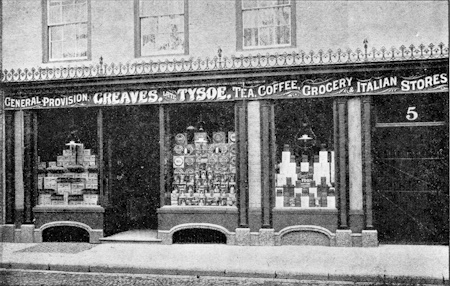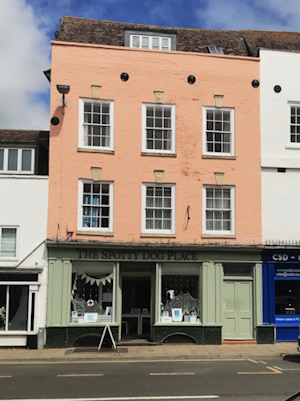Tysoe’s Court
to Expand
The triangle of buildings behind Frisby’s at the Cross, extending along the first few yards of the High Street and Barton Street, differ from the other properties along the main streets in that they are not ‘front houses’ to burgage plots. They are likely to be medieval infill to what was once an open market square at the centre of the town. Tysoe’s Court, which is between 5 and 6 Barton Street isn’t an alley, as there is no public thoroughfare. It gave access to the rear of the property where business facilities were located. In this case there were no cottages. There were warehouses and a stable, dating back at least to the seventeenth century.
The first occupier of the front house we have a record of is Nicholas Player, a cooper. The buildings in the court would have been his workshops and stores.
Mr Player died in 1830 and No 5 was sold to Thomas and Sarah Bowers, becoming a grocer’s and cheese factor’s shop. Thomas’s early death in 1845 necessitated the sale of the business. The Tysoe dynasty arrived, and the court acquired its name.
Charles Tysoe came from a farming family in Upper Swell. He built a thriving business whilst his son, Congreve, had to serve a long apprenticeship. Charles wasn’t a man to retire and it wasn’t until his death in 1891 that Congreve took over the reins. He only survived his father by nine years, though, dying in 1900 at the early age of 52 years. Though he had five sons and two daughters the eldest were only in their teens and not ready to run the shop. The business was transferred to Mr George Greaves, whose name appeared alongside the Tysoe name in a photograph from 1903.
The Tysoes didn’t go away. The women retained ownership of the building, with Congreve’s widow Ellen inheriting it from her husband. She in turn passed it on to her two daughters, Grace and Muriel, so it really was a family business. They also owned, and rented out, No 6 next door.
to Expand
Mr Greaves remained until 1906, when he sold the business back to the family, this time to John William (Jack) Tysoe, who was now aged 23. Already well known for their cheeses, Jack developed this trade, becoming a cheese wholesaler as well as retailer. The name Tysoe was synonymous with cheese in Tewkesbury. In 1919, when Mr Hawley of 93 Church Street died his grocery business was taken over by the Tysoes and became their second branch. Jack remained at the helm until his retirement, in 1955.
There was no Tysoe successor, and the fixtures and fittings were sold, after 110 years of trading. For a while the shop remained as a grocery. In 1964 it became Tewkesbury’s first launderette, then a clothes shop, an ephemera shop and a tattoo studio. It is currently now (2024) an arts and crafts gift shop.
The old warehouses and stable in the court didn’t last as long. They were demolished in the 1970s.
At some point in the past the building was altered to move the entrance to the court from No 5 to No 6. This was done by creating a dog-leg, presumably to create extra trading space for the grocery business. At the same time the frontage was altered to extend the fascia over the shop-front and to fit a wrought iron balustrade along No 5 and the new Tysoe’s Court entrance. As the buildings were in common ownership for much of the past two centuries it isn’t clear who made the alterations and when. In the current works on the building, evidence for the previous straight line of the court was uncovered and the entrance has been moved back to its original location. The balustrade has been removed from No 5 as well, though it remains on No 6.
The Tysoe family name is not as well known as other successful traders of the period, because they never sought public office. There were no Tysoe Councillors or Mayors. They were involved in town life in other ways, though. They were active in the cricket, hockey, rowing and bowls clubs. The regatta was always celebrated with special offers in the shop. Congreve was heavily involved in the early hospital, as a donor and official visitor and was an active ‘old boy’ of the Abbey House School. Jack was a Special Constable and a founder member of the Rotary Club. Their name is remembered in the newly refurbished court, though it no longer carries the odours of cheese, ham and freshly ground coffee.




Comments